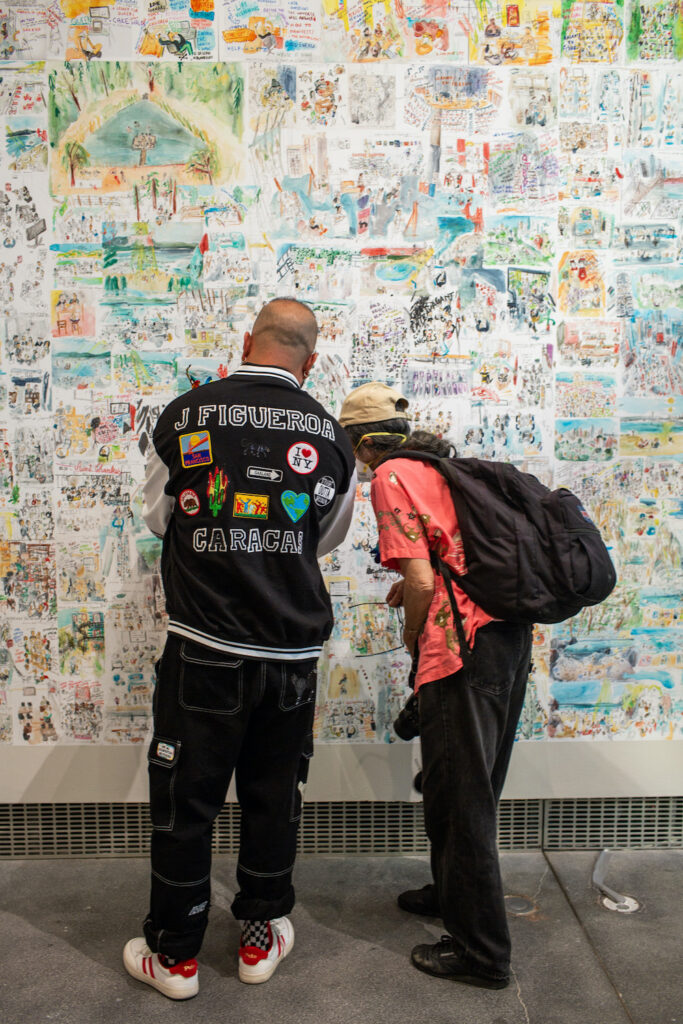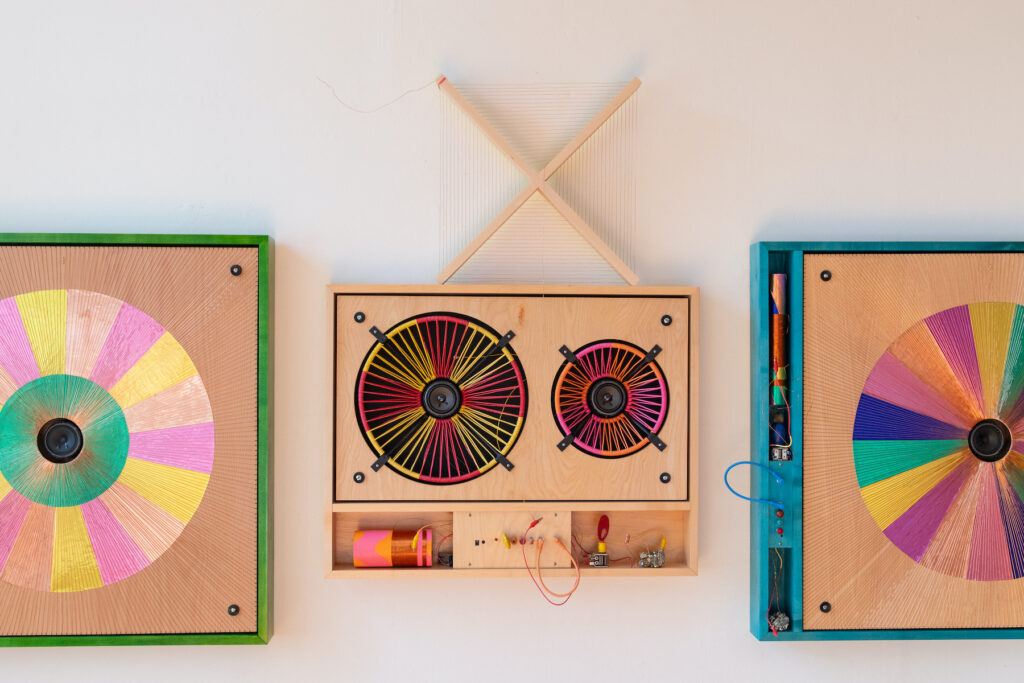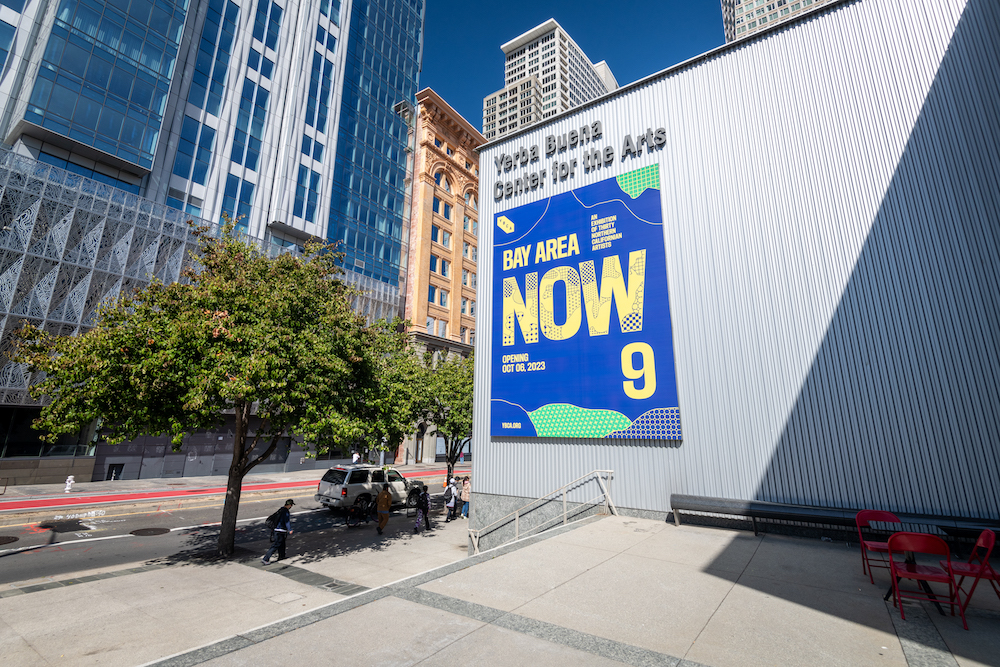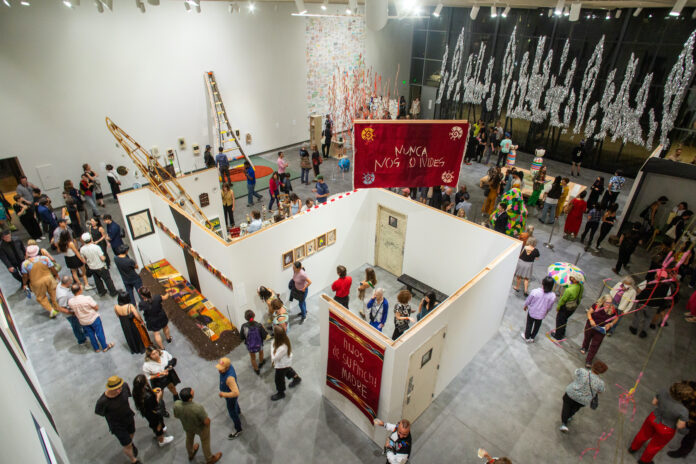“What does downtown need right now?”
That was the question posed by Yerba Buena Center for the Arts CEO Sara Bahat during the press preview for “Bay Area Now 9” (which runs through May 5.) She never used the term “doom loop,” but then, it wasn’t really necessary. We all see the headlines every day, we walk the streets of this city, we know all about the idiotic sprung-from-South-African-apartheid billionaire who openly vows to interfere with local politics as their overrated companies burn money. San Franciscans know that term; mainly because non-San Franciscans can’t think of a better one.
>>READ DEWITT CHEN’S “BAN9” REVIEW ON THE ENDURING IMPORTANCE OF BAY ARTISTS<<
Acknowledging economic inequality will always be awkward for YBCA, as illustrated by the very fact that they have a CEO to begin with. It’s an arts org that boasts a fantastic venue and a diverse array of creative mediums, but it’s always been structured like century-year-old bank. Sure, plenty of small, non-profit arts orgs hold fundraisers, galas, and auctions, but YBCA has its own goddamn lottery—one that gives away prizes worth millions of dollars each year, including a house. So, when such an institution’s CEO asks how downtown SF can improve, one really wants to believe they aren’t asking in the same way the aforementioned billionaire would. (This is a valid concern, considering that the press preview occurred on the same day the YBCA was hosting Techstars Foundercon in the same building.)

Still, the appeal in returning to YBCA time after time is, in fact, to see the eclectic array of artists and styles on display. The same press preview saw Amy Kisch, YBCA’s head of art and public programming, say that the ninth BAN collection was necessary because, “We give the other narrative of San Francisco.” That’s debatable, but the focus of the annual curation is to assemble works exclusively by artists who are residents of the Bay Area, giving them the chance to have their work displayed for the lucrative donors and tourists who frequent YBCA.
As it happens, I listened to these opening remarks seated on the corner of a Japanese engawa bench, which also featured two tall “animated” Kokeshi dolls. These pieces were the work of Berkeley-based Masako Miki. They were subtle and comforting, blending into the surrounding room without stealing focus (save for the Kokeshi.) The engawa is the sort of piece one could easily see being out in the world, appreciable for its practicality without even noticing its craft.
A wall-based installation that caught my attention was that of Berkeley-based Peter Simensky. His new “Decoy—Radio Transmitter” collection almost seems like a tribute to the roots of hip-hop (a genre currently celebrating its 50th anniversary) as both an art form and an innovation. The Portland-born Simensky uses an assembly of wires, amplifiers, and other materials to essentially create a giant wall of working speakers, all shaped like old-school boomboxes, all thin as picture frames. I don’t recall what music was coming out of them during the press preview in an echo-y hall, but as an ‘80s kid, I tend to have a visceral reaction to the sight of a boombox.

I had a similar “flashback” walking through “Oñí Ocan,” the multi-channel video piece by Courtney Desiree Morris, who is also from Berkeley. The Yoruba-inspired piece, which I was told was still a work-in-progress, features an altar in the center, meant to pay tribute to the orisha Oshun. The videos projected on the walls feature different Black people—mostly femme-bodied—in bathtubs covering themselves in honey, which the notes describe as one of Oshun’s healing balms. (Cue my semi-flashback as I thought of the album cover for the Ohio Players’ Honey.) That same text describes Oshun as “the patron orisha of sex workers and LGBT individuals.” I later found little evidence to support that description, but such protective auras do have a great deal of precedence in traditional African religions. Besides, everyone deserves to have a higher power on their side.
As striking as those and other installations are, one also attends a “Bay Area artist showcase” hoping a few of the creatives were born in or at least grew up here. Such is true of photographer Janet Delaney. Amongst the many works on the upper level of YBCA, there are her photos of the ever-changing face of SF. Her photos “Saturday Afternoon, Howard between 3rd and 4th Streets” (1981) and “Oracle Convention, Howard between 3rd and 4th Streets” (2016) are jaw-dropping in how they capture the radical differences that have taken place in just one pocket of my hometown over 35 years. (The fact that the former photo was taken the year I was born gave it even more resonance for me personally.)

And so went my preview-jaunt through the works of 30 Bay Area artists of varied disciplines and mediums. It would take too long to detail them all (though I highly recommend Golbanou Moghaddas’ and Nyame O. Brown’s installations), but “BAN9” well fulfills its purpose as a showcase of diverse Bay Area talent. I left the building still kicking myself for having forgotten my Aranet4 at home (almost none of the conference folk were masked, but we “BAN9” visitors mostly were, and there were masking stations all about despite YBCA being a mask-optional facility.) I didn’t get a few steps before I encountered someone homeless and hungry. I gave them the snacks I’d gotten at the two events inside the building, and found myself unable to shake the thought that he’s just the sort of person who will never be allowed into the YBCA. The institution should be commended for exposing these 30 artists to a larger audience, but there’s still a wide chasm between those it is working and patronizing, and those who never get the chance to even experience the works that may or may not reflect their own existence.
Still, it’s a fine collection of art. If that’s all you’re looking for, you’re not likely to be disappointed.
BAY AREA NOW 9 runs through May 5. Yerba Buena Center for the Arts, SF. Tickets and more info here.





